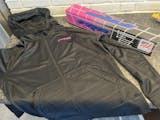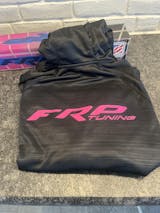· By Ryan Hogan
Okay, I want an FRP tune- Now what?
Hi and welcome to FRP.
If you're reading this, odds are you were directed here looking for parts, or services, or both.
We are in the racing parts business and offer programming that compliments your vehicle and said parts.
A question we are often asked is, "How do I get an FRP tune?". Or, "How does remote tuning work?" The answers to these questions will be explained in the next several paragraphs below.
The first criteria that we need to know to walk through this process is what year/engine/transmission the vehicle in question has. We cover 25+ years worth of platforms. Within that range, there are select few vehicles that are not supported, or have better on one form of software compared to another, etc. At the time of publishing this post, we use HPTuners and SCT. While there is some overlap in support, generally, SCT is used on 96-06 "JTEC/JTEC+" vehicles, and HPtuners is used exclusively 2005 to present vehicles. HPTuners does support 96-2004 vehicles to some extent.
The other item of importance that dictates how this process is conducted is what "level" of tuning is needed.
If the vehicle is as-is from manufacturer, or has minor modifications, such as cold air intake, cat-back exhaust, etc. we have "canned" tunes available. These canned tunes are meant to be known good files based on our years of experience with these vehicles. They generally do not need much, if any, revising.
If the vehicle is substantially modified with items like (but not limited to) non-OEM injectors , non-OEM camshaft , ported heads, etc, turbo, or supercharger , custom tuning is required. It is important to note that remote Custom Tuning is a process- unlike our canned tunes, it will require multiple revisions. It will require you as the end user to do your part in the form of datalogging, with a wideband O2 sensor to monitor air/fuel ratio. It will also require the vehicle to be up to par mechanically, as the tuning we do is only as good as the data that is presented to us.
For forced induction applications (supercharged/turbocharged), please select our Forced Induction Tuning package. This will cover tuning as required to handle converting the tune for use with an SRT-4 2-bar (or 3 bar) MAP sensor, larger injectors, and other supporting modifications. Wideband O2 and datalogging is required.
Now that we have gone over the basics of what tuning is, so to speak, let's get into the actual process.
SCT
With SCT, we start by filling out the tuning form at point of purchase . Tunes are specific to model, year, and the controller part number itself. To do this , we need the PCM (Powertrain Control Module) P/N, found on the white sticker of the PCM itself. It is usually found in small black text, or in some cases may be hand-written. It is usually 8 numbers, followed by 2 letters, e.g. 56040145AG. Beyond this detail, we need other info about the engine when known, as well as what octane tunes are needed.
For canned tunes, we pre-load the tunes themselves onto the SCT X3 (P/N 3200) and ship it out. When you receive it in the mail, it comes ready to use. Plug it into the OBD2 port (usually under the steering column on most Dodge trucks and Jeeps), , select Program Vehicle, and follow the prompts. Tune loads should take 3-5 minutes, and afterwards the handheld can be removed from the OBD2 port.
For custom tuning, we pre-load a start-up tune into the SCT X3 (P/N 3200) and ship it out. It is important to note that the start-up tune is not by ANY means a finalized tune, but rather something to get the vehicle running strictly for the purposes of datalogging immediately afterwards. When you receive it in the mail, it comes ready to use. Plug it into the OBD2 port (usually under the steering column on most Dodge trucks and Jeeps), , select Program Vehicle, and follow the prompts. Tune loads should take 3-5 minutes, and afterwards the handheld can be removed from the OBD2 port. The next step would be datalogging with the SCT Livelink Gen II program. See our link "SCT Datalogging Guide" (currently a PDF via email, blog post coming soon) for detailed instructions on how to datalog with SCT.
After the start-up tune is loaded, the process consists of you sending us datalogs- we look at the data, send revised tunes, and re-log until we are both satisfied with the vehicle's operation. Most naturally aspirated vehicles take 4-7 revisions, while Forced Induction combos take more like 6-10 files.
It is important to note that any additional modifications (raising boost, changing cams, porting heads, etc) do constitute additional re-tuning.
HPTuners
With HPTuners, we start by filling out the tuning form at point of purchase . Tunes are specific to model, year, and the vehicle itself. Beyond these details we need other info about the engine when known, as well as what octane tunes are needed.
Regardless of the level of tuning needed, with HPTuners, the tuning process begins with the customer sending us a copy of the vehicle's calibration. We must have this in order to get started. The tunes are not "pre-loaded" as we need the vehicle's file first .
Once you the end user has an HPtuners cable (often referred to as an interface), you will email us a copy of the vehicle's calibration. This is often referred to as the "read file" . We will then send a modified file.
For canned tunes, this is typically a one-and-done process. We do recommend datalogging just for the sake of safety.
For custom tuning, after sending us a copy of the vehicle's calibration, we will send a start-up tune. It is important to note that the start-up tune is not by ANY means a finalized tune, but rather something to get the vehicle running strictly for the purposes of datalogging immediately afterwards.
After the start-up tune is loaded, the process consists of you sending us datalogs- we look at the data, send revised tunes, and re-log until we are both satisfied with the vehicle's operation. Most naturally aspirated vehicles take 4-7 revisions, while Forced Induction combos take more like 6-10 files.
It is important to note that any additional modifications (raising boost, changing cams, porting heads, etc) do constitute additional re-tuning.
For more detailed information, please see our blog post about HPtuners initial instructions.


